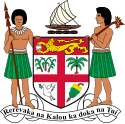1982 Fijian general election
| |||||||||||||||||||||||||||||||||||||
All 52 seats in the House of Representatives 26 seats needed for a majority | |||||||||||||||||||||||||||||||||||||
|---|---|---|---|---|---|---|---|---|---|---|---|---|---|---|---|---|---|---|---|---|---|---|---|---|---|---|---|---|---|---|---|---|---|---|---|---|---|
| |||||||||||||||||||||||||||||||||||||
| |||||||||||||||||||||||||||||||||||||
 |
|---|
General elections were held in Fiji between 10 and 17 July 1982.[1] The paradoxical results were both a triumph and a setback for the Alliance Party of the Prime Minister, Kamisese Mara. The Alliance received 52% of the popular vote, only slightly down on its previous total, but won only 28 seats, eight fewer than in the previous elections of September 1977. Part of the reason for this discrepancy was that the slight surge in support for Mara's Alliance in the Indo-Fijian community, from 14 percent to 16 percent, was not sufficient to translate into seats in Fiji's communal electoral system, and did not therefore off-set losses among the ethnic Fijian community, particularly in the west of the country. The Western United Front of Osea Gavidi won only two seats, but split the vote, allowing the National Federation Party (NFP), with which it tactically allied itself, to gain seven seats for a total of 22. The NFP, which had split into two factions before the previous elections, had been reunited.
Campaign[edit]
A total of 137 candidates contested the 52 seats in the House of Representatives.[2] One candidate – Subramani Basawaiya of the National Federation Party – was elected unopposed in the Savusavu–Macuatu East Indo-Fijian communal constituency, after his sole opponent, Alliance Party candidate Shiu Prasad, withdrew from the contest shortly before the elections. The Alliance claimed the withdrawal was tactical, as it would mean Indo-Fijian voters would be less likely to come out to vote, giving the Alliance an advantage in the national constituencies.[3]
The Fijian Nationalist Party campaigned on a 'Fiji for the Fijians' platform, with their manifesto including policies of reserving 46 of the 52 seats in the House of Representatives for Fijians and returning all freehold and crown lands to the Fijian community.[4]
The Fijian-dominated Western United Front, established in July 1981 and led by Osea Gavidi, formed an electoral pact with the Indo-Fijian dominated National Federation Party, resulting in the NFP standing down in six Fijian national constituencies to allow the WUF to run.[5]
Results[edit]
The Alliance received 86% of the vote in the Fijian communal constituencies, with the WUF on 7% and the NFP just 0.8%. In Indo-Fijian communal constituencies the NFP received 84% of the vote and the Alliance 15%.
Three deputy ministers lost their seats; Bill Clark, Ishwari Prasad Bajpai and Sakiasi Waqnivavalagi.[6]
| Party | Votes | % | Seats | +/– | |
|---|---|---|---|---|---|
| Alliance Party | 507,163 | 51.79 | 28 | –8 | |
| National Federation Party | 403,548 | 41.21 | 22 | +7 | |
| Western United Front | 37,266 | 3.81 | 2 | New | |
| Fijian Nationalist Party | 27,329 | 2.79 | 0 | 0 | |
| Independents | 3,903 | 0.40 | 0 | –1 | |
| Total | 979,209 | 100.00 | 52 | 0 | |
| Valid votes | 979,209 | 98.04 | |||
| Invalid/blank votes | 19,605 | 1.96 | |||
| Total ballots cast | 242,712 | – | |||
| Registered voters/turnout | 292,341 | 83.02 | |||
| Source: Nohlen et al. | |||||
Aftermath[edit]
Following the elections, Mara formed a fifteen-member cabinet.
| Position | Minister |
|---|---|
| Prime Minister | Kamisese Mara |
| Deputy Prime Minister Minister of Fijian Affairs and Rural Development |
Penaia Ganilau |
| Attorney General | Manikam Pillai |
| Minister of Agriculture and Fisheries | Jonati Mavoa |
| Minister of Communications and Works | Semesa Sikivou |
| Minister of Economic Planning and Development | David Toganivalu |
| Minister of Education and Youth | Ahmed Ali |
| Minister of Energy and Minerals | Peter Stinson |
| Minister of Employment and Industrial Relations | Mohammed Ramzan |
| Minister of Finance | Charles Walker |
| Minister of Foreign Affairs Minister of Tourism |
Mosese Qionibaravi |
| Minister of Health and Social Welfare | Apenisa Kurisaqila |
| Minister of Home Affairs | William Toganivalu |
| Minister of Lands, Local Government and Housing | Militoni Leweniqila |
| Minister of Transport and Civil Aviation | Ted Beddoes |
| Minister of State for Co-operatives | Livai Nasilivata |
| Minister of State for Forests | Josaia Tavaiqia |
| Minister without Portfolio | Apisai Tora |
| Source: Pacific Islands Monthly | |
See also[edit]
References[edit]
- ^ Dieter Nohlen, Florian Grotz & Christof Hartmann (2001) Elections in Asia: A data handbook, Volume II, p653 ISBN 0-19-924959-8
- ^ Elections in PNG, Fiji Pacific Islands Monthly, August 1982, p5
- ^ Fiji candidates 'tactical retreat' Pacific Islands Monthly, July 1982, p5
- ^ Fiji, PNG: Two elections, two issues Pacific Islands Monthly, May 1982, p5
- ^ Balanced strength as parties prepare for Fiji elections Pacific Islands Monthly, June 1982, pp11–13
- ^ Fiji's poll of records: Most voters, most bitterness, most mud-slinging Pacific Islands Monthly, September 1982, pp10–13


